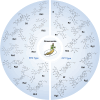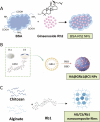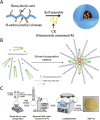Unlocking ginsenosides' therapeutic power with polymer-based delivery systems: current applications and future perspectives
- PMID: 40709093
- PMCID: PMC12287023
- DOI: 10.3389/fphar.2025.1629803
Unlocking ginsenosides' therapeutic power with polymer-based delivery systems: current applications and future perspectives
Abstract
Ginsenosides, as the main active ingredient of Panax plants, have been found to have extensive pharmacological activity and clinical therapeutic potential in recent years. However, its inherent physical and chemical properties such as poor solubility and low intestinal permeability result in low bioavailability, severely limiting its clinical application and translation. To address these challenges, polymeric carriers-valued for their excellent biocompatibility, structural tunability, and intelligent response functions-have been engineered to: (i) enhance solubilization via polymer conjugation and amphiphilic micellar encapsulation; (ii) achieve passive (EPR-mediated) and active (ligand-directed) tumor targeting to minimize off-target distribution; and (iii) enable on-demand drug release through pH-, ROS-, temperature-, and enzyme-responsive designs. In this review, we delve into the mechanistic principles and synergistic interactions underlying each functional module within a cohesive, function-centred design roadmap. Finally, we explore emerging interdisciplinary directions-including AI-guided polymer design, logic-gated nanocarriers, and microfluidic personalized fabrication-that promise to accelerate the bench-to-bedside translation of multifunctional ginsenoside therapeutics.
Keywords: artificial intelligence; bioavailability enhancement; drug delivery system design 1. introduction; ginsenosides; polymer-based drug delivery system.
Copyright © 2025 Yu, Lu, Chen, Deng and Liu.
Conflict of interest statement
The authors declare that the research was conducted in the absence of any commercial or financial relationships that could be construed as a potential conflict of interest.
Figures










Similar articles
-
Management of urinary stones by experts in stone disease (ESD 2025).Arch Ital Urol Androl. 2025 Jun 30;97(2):14085. doi: 10.4081/aiua.2025.14085. Epub 2025 Jun 30. Arch Ital Urol Androl. 2025. PMID: 40583613 Review.
-
Nucleic Acid Nanocapsules as a New Platform to Deliver Therapeutic Nucleic Acids for Gene Regulation.Acc Chem Res. 2025 Jul 1;58(13):1951-1962. doi: 10.1021/acs.accounts.5c00126. Epub 2025 Jun 9. Acc Chem Res. 2025. PMID: 40491030
-
Comparison of self-administered survey questionnaire responses collected using mobile apps versus other methods.Cochrane Database Syst Rev. 2015 Jul 27;2015(7):MR000042. doi: 10.1002/14651858.MR000042.pub2. Cochrane Database Syst Rev. 2015. PMID: 26212714 Free PMC article.
-
Emerging Trends in Designing the Dendrimer-Based Drug Delivery for Antineoplastic Therapies.ACS Appl Bio Mater. 2025 Jul 21;8(7):5462-5495. doi: 10.1021/acsabm.5c00498. Epub 2025 Jun 23. ACS Appl Bio Mater. 2025. PMID: 40549423 Review.
-
DS-Modified Paeoniflorin pH-Responsive Lipid-Polymer Hybrid Nanoparticles for Targeted Macrophage Polarization in a Rat Model of Rheumatoid Arthritis.Int J Nanomedicine. 2025 Jul 12;20:8967-8992. doi: 10.2147/IJN.S516434. eCollection 2025. Int J Nanomedicine. 2025. PMID: 40671689 Free PMC article.
References
-
- Aalinkeel R., Kutscher H. L., Singh A., Cwiklinski K., Khechen N., Schwartz S. A., et al. (2018). Neuroprotective effects of a biodegradable poly(lactic-co-glycolic acid)-ginsenoside Rg3 nanoformulation: a potential nanotherapy for Alzheimer’s disease? J. Drug Target 26, 182–193. 10.1080/1061186X.2017.1354002 - DOI - PubMed
Publication types
LinkOut - more resources
Full Text Sources

